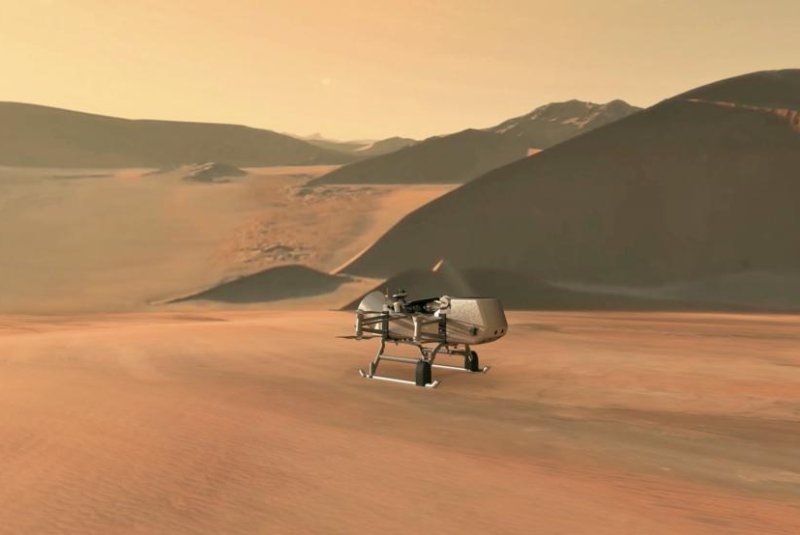An artistic rendering shows NASA’s drone-like rotorcraft Dragonfly landing on Titan, Saturn's largest moon. Photo by NASA/JHU-APL
June 27 (UPI) -- For the space agency's next mission to a new destination in the solar system, NASA will send a miniature helicopter to Titan, Saturn's largest moon. NASA announced the upcoming mission at a press conference on Thursday afternoon.
The drone-like rotorcraft-lander, dubbed Dragonfly, will take advantage of Titan's dense atmosphere and low gravity, traveling to and from a variety of test sites in search of signs of biological activity. Dragonfly will be the first multi-rotor vehicle deployed on another planet.
Scientists estimate Titan is similar to primordial Earth in many ways. Investigations of the moon could offer planetary scientists new insights into how life on Earth first emerged.
The rotorcraft is scheduled to launch in 2025 and land on Saturn's moon in 2034. After its nearly decade-long, 888-million-mile journey through the solar system, Dragonfly will execute daily trips to interesting locations on Titan's surface, including the bed of an impact crater and windswept dunes. Dragonfly's instruments will study prebiotic chemistry in the moon's subsurface ocean and liquid reservoirs.
Nitrogen and methane are abundant in Titan's atmosphere. Research suggests the chemicals react with radiation to form complex organic molecules. Some scientists hypothesize that these molecules could react with water on Titan's surface to yield amino acids, the building blocks of life.
Titan's complex geography offers a wide variety of interesting places -- rivers, lakes, oceans, dunes, craters -- to look for these prebiotic molecules.
"Titan is unlike any other place in the solar system, and Dragonfly is like no other mission," Thomas Zurbuchen, NASA's associate administrator for science at the agency's headquarters, said in a news release. "It's remarkable to think of this rotorcraft flying miles and miles across the organic sand dunes of Saturn's largest moon, exploring the processes that shape this extraordinary environment. Dragonfly will visit a world filled with a wide variety of organic compounds, which are the building blocks of life and could teach us about the origin of life itself."
The Dragonfly mission is part of NASA's New Frontiers program, which has produced New Horizons' trek to Pluto and the Kuiper Belt, Juno's trip to Jupiter and OSIRIS-REx's mission to the asteroid Bennu.
"The New Frontiers program has transformed our understanding of the solar system, uncovering the inner structure and composition of Jupiter's turbulent atmosphere, discovering the icy secrets of Pluto's landscape, revealing mysterious objects in the Kuiper belt, and exploring a near-Earth asteroid for the building blocks of life," said Lori Glaze, director of NASA's Planetary Science Division. "Now we can add Titan to the list of enigmatic worlds NASA will explore."















